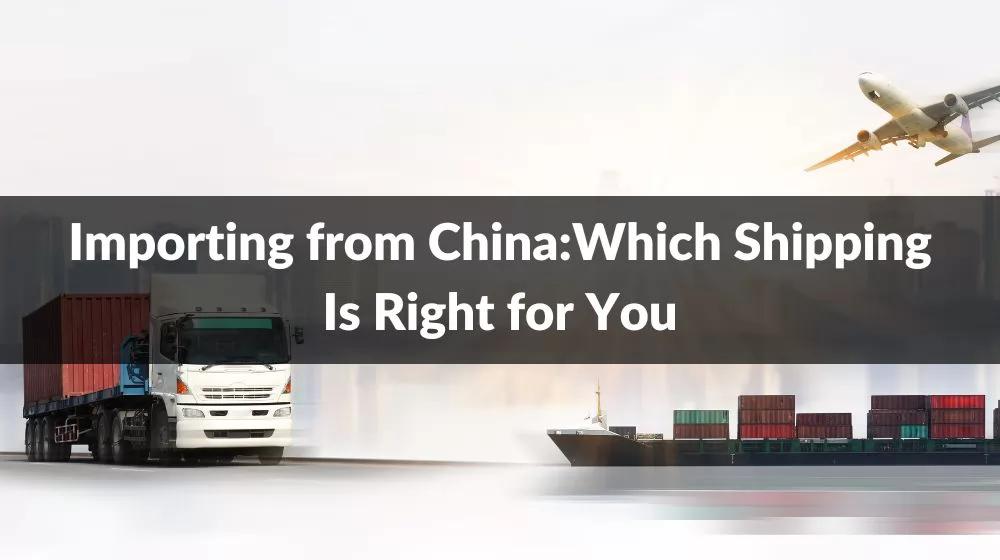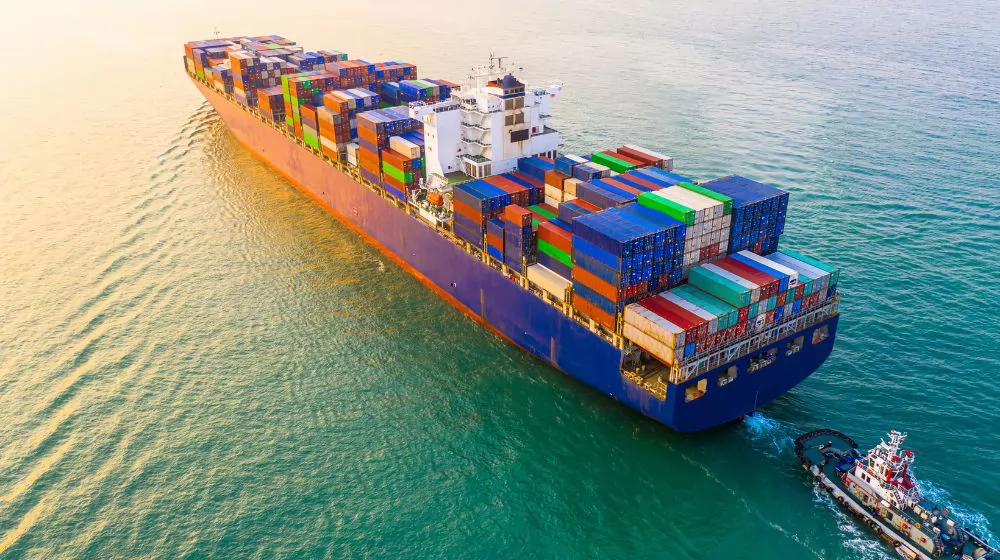
Table of contents:
In the vast landscape of global trade, importing goods from China has become a strategic imperative for businesses seeking competitive advantages. As you embark on this journey, a critical decision awaits — choosing the right shipping method. The diverse options available can significantly impact the success of your importation venture, making it imperative to navigate these waters with careful consideration.
Overview of Importing from China
Importing from China has become a crucial aspect of global business operations due to the country's prominent role in the manufacturing industry. With its vast array of products and competitive prices, China serves as a primary source for businesses worldwide. This overview aims to shed light on the key considerations and processes involved in importing from this economic giant.
China's Manufacturing Dominance:
China has emerged as a manufacturing powerhouse, producing a diverse range of products spanning electronics, textiles, machinery, and more. Its cost-effective production capabilities make it an attractive destination for businesses seeking affordable and high-quality goods.
Market Accessibility:
The accessibility of Chinese products in the international market has opened doors for businesses of all sizes to explore cost-effective sourcing solutions. From small enterprises to multinational corporations, importing from China has become a strategic choice for obtaining goods that meet varying market demands.
Regulatory Landscape:
Navigating the regulatory landscape is a crucial aspect of importing from any country, and China is no exception. Understanding the legal requirements, import restrictions, and compliance standards is essential to ensure a smooth and lawful import process.
Cultural Considerations:
Effective communication and understanding of cultural nuances are vital when dealing with Chinese suppliers. Building strong relationships based on mutual respect and trust can contribute significantly to the success of importing endeavors.
Supply Chain Dynamics:
China's vast network of suppliers and manufacturers necessitates a keen understanding of supply chain dynamics. This includes assessing the reliability of suppliers, monitoring production processes, and ensuring timely deliveries to meet market demands.
Economic Factors:
Fluctuations in currency exchange rates, economic policies, and other macroeconomic factors can impact the cost and feasibility of importing from China. Staying informed about these variables is crucial for making strategic decisions in the global market.
Innovation and Technology:
China's commitment to innovation and technology has led to advancements in various industries. Importers can benefit from the latest technologies and innovative products by establishing collaborations with forward-thinking Chinese manufacturers.

Importance of Choosing the Right Shipping Method
The success of an importation venture from China hinges significantly on the careful selection of the appropriate shipping method. The choice made in this regard impacts not only the cost but also the efficiency and reliability of the entire supply chain. Understanding the importance of choosing the right shipping method is paramount for businesses seeking to optimize their import processes.
Cost Efficiency:
The cost of shipping can be a substantial portion of the overall expenses in importing goods. Choosing the right shipping method involves finding a balance between cost and speed. While air freight may be faster, it tends to be more expensive compared to sea freight. A comprehensive cost analysis is essential to identify the most cost-efficient option for the specific needs of the business.
Product Characteristics:
The nature of the imported products plays a crucial role in determining the suitable shipping method. Fragile or perishable items may require faster transportation methods like air freight to ensure their integrity upon arrival. On the other hand, durable and non-perishable goods can often be shipped economically via sea freight.
Transit Time:
Meeting customer expectations in terms of delivery times is vital for maintaining a competitive edge. Understanding the transit times associated with different shipping methods is essential for planning inventory, managing stock levels, and meeting market demand promptly.
Customs and Regulatory Compliance:
Each shipping method has its implications regarding customs and regulatory compliance. Choosing a shipping method that aligns with the regulatory requirements of both the exporting and importing countries is crucial for avoiding delays and potential legal issues.
Environmental Considerations:
In an era where environmental sustainability is gaining prominence, choosing a shipping method with lower environmental impact can be a strategic decision. Businesses are increasingly considering eco-friendly options to align with corporate social responsibility goals.
Flexibility and Scalability:
The chosen shipping method should provide the necessary flexibility and scalability to accommodate changes in business volume and market demand. A shipping solution that can adapt to varying shipment sizes and frequencies contributes to a more agile and responsive supply chain.
In conclusion, the importance of selecting the right shipping method cannot be overstated. It requires a careful evaluation of various factors, including cost, product characteristics, transit time, regulatory compliance, environmental considerations, and scalability. Businesses that invest time and effort in making informed decisions regarding their shipping methods are better positioned to enhance their competitiveness in the global marketplace.
Common Shipping Methods from China
When importing goods from China, understanding the various shipping methods available is crucial for making informed decisions that align with your business requirements. China offers a range of shipping options, each with its advantages and considerations. Here are some common shipping methods:
Sea Freight:
Overview: Sea freight, also known as ocean freight, is one of the most economical shipping methods for large and non-urgent shipments.
Advantages: Cost-effective for bulk shipments, suitable for goods with longer lead times, and accommodates large cargo volumes.
Considerations: Longer transit times compared to air freight, making it essential to plan inventory and production accordingly.
Air Freight:
Overview: Air freight is known for its speed and efficiency, making it ideal for time-sensitive or high-value shipments.
Advantages: Faster transit times, reliable for perishable or high-demand products, and provides better tracking capabilities.
Considerations: Generally more expensive than sea freight, suitable for smaller shipments due to space constraints.
Rail Freight:
Overview: Rail freight offers a middle ground between sea and air freight, providing a cost-effective and faster option than sea freight.
Advantages: Faster than sea freight and more cost-effective than air freight, especially for shipments traveling overland.
Considerations: Availability and efficiency may vary depending on the specific rail routes and infrastructure.
Courier Services:
Overview: Courier services, like DHL, FedEx, and UPS, provide door-to-door delivery and are commonly used for smaller shipments.
Advantages: Fast and reliable delivery, end-to-end tracking, and suitable for smaller, urgent shipments.
Considerations: Generally higher shipping costs per unit, making it more suitable for high-value or time-sensitive products.
Express Shipping:
Overview: Express shipping services, often provided by freight forwarders, offer a combination of air, sea, and land transportation.
Advantages: Versatility in terms of speed and cost, providing tailored solutions based on shipment requirements.
Considerations: Costs may vary based on the chosen transportation modes, and careful planning is needed to optimize efficiency.
Dropshipping:
Overview: In dropshipping, the supplier ships products directly to the end customer, eliminating the need for the importer to handle inventory.
Advantages: Low upfront costs, reduced inventory management, and a flexible business model.
Considerations: Reliance on supplier reliability, potential longer shipping times, and limited control over the fulfillment process.
Understanding the nuances of each shipping method is essential for making informed decisions that align with your business goals, budget constraints, and the nature of your products. Whether prioritizing cost efficiency, speed, or a combination of both, choosing the right shipping method is a critical step in ensuring a smooth and successful importing process from China.

Choosing the Right Shipping Partner
Selecting the right shipping partner is a pivotal decision in the importation process from China. The shipping partner plays a crucial role in ensuring the efficiency, reliability, and overall success of the supply chain. Here are key considerations when choosing the right shipping partner:
Reputation and Experience:
Reputation Matters: Look for shipping partners with a solid reputation for reliability and professionalism. Online reviews, testimonials, and industry reputation are valuable indicators.
Experience Counts: An experienced shipping partner is likely to have a robust understanding of international logistics, potential challenges, and effective problem-solving skills.
Global Network and Reach:
International Presence: A shipping partner with a global network ensures smoother transportation and can navigate complex international logistics seamlessly.
Local Expertise: Local partners in both China and the destination country can provide valuable insights and assistance in handling customs procedures and regulations.
Shipping Services Offered:
Mode of Transportation: Evaluate the range of shipping services offered, including sea freight, air freight, rail freight, and courier services. The ability to provide flexible solutions caters to diverse business needs.
Specialized Services: Consider if the shipping partner offers specialized services, such as temperature-controlled transportation for perishable goods or oversized cargo handling.
Cost Transparency and Flexibility:
Transparent Pricing: Ensure that the shipping partner provides transparent pricing structures, including all relevant fees and charges. Hidden costs can significantly impact the overall budget.
Flexible Options: A shipping partner offering flexibility in terms of shipping options and pricing models allows businesses to choose services that align with their specific requirements.
Technology and Tracking:
Advanced Technology: A shipping partner utilizing modern technology and tracking systems enhances visibility into the supply chain, allowing for real-time monitoring and proactive issue resolution.
Communication Channels: Effective communication channels with the shipping partner contribute to better coordination and the ability to address concerns promptly.
Compliance and Documentation:
Regulatory Compliance: Ensure that the shipping partner is well-versed in international trade regulations, customs procedures, and documentation requirements.
Accuracy in Documentation: Accurate and timely preparation of shipping documents is critical for avoiding delays and ensuring a smooth customs clearance process.
Customer Support:
Responsive Support: A shipping partner with responsive customer support can address queries, provide updates, and resolve issues promptly.
Availability: Consider the availability of customer support across different time zones, especially when dealing with international shipments.
Insurance Coverage:
Cargo Insurance: Verify if the shipping partner offers cargo insurance coverage. Insurance protects against potential damage, loss, or theft during transportation.
Choosing the right shipping partner involves a comprehensive assessment of their reputation, experience, global network, services offered, cost transparency, technology integration, compliance, customer support, and insurance options. This careful selection ensures a reliable and efficient logistics partner, contributing to the overall success of the importing process from China.
Tips for a Smooth Shipping Process
A seamless shipping process is vital for the success of any importation endeavor from China. Whether you're a seasoned importer or venturing into international trade for the first time, the following tips can help ensure a smooth shipping process:
Plan Ahead:
Lead Time Considerations: Plan your orders well in advance, considering production lead times, shipping durations, and potential delays. Adequate planning minimizes the risk of running out of stock or missing critical deadlines.
Understand Shipping Regulations:
Research Customs Requirements: Familiarize yourself with the customs regulations and import requirements of both China and your destination country. Compliance is key to avoiding delays and legal issues.
Choose the Right Incoterms:
Define Responsibilities: Clearly define responsibilities and liabilities by choosing the appropriate Incoterms (International Commercial Terms) in your agreements with suppliers. This helps avoid misunderstandings regarding shipping costs and responsibilities.
Packaging Matters:
Secure and Compliant Packaging: Ensure that your products are securely packaged to withstand the rigors of transportation. Compliance with packaging regulations helps prevent damage and ensures smooth customs clearance.
Consolidate Shipments:
Combine Orders Where Possible: Consolidating multiple orders into one shipment can be cost-effective. It reduces shipping expenses and simplifies logistics, making the process more efficient.
Use Reliable Shipping Partners:
Vet Shipping Partners: Choose reputable and reliable shipping partners with a proven track record. Research customer reviews, check references, and verify their experience in handling shipments from China.
Implement Technology Solutions:
Track and Monitor Shipments: Utilize technology solutions for real-time tracking and monitoring of shipments. This visibility enables proactive problem-solving and keeps you informed about the status of your goods.
Insure Your Shipments:
Cargo Insurance: Consider securing cargo insurance to protect your goods against damage, loss, or theft during transit. While it adds an additional cost, it provides financial security in case of unforeseen events.
Communication is Key:
Regular Communication: Maintain open and regular communication with your suppliers and shipping partners. Promptly address any issues or concerns to prevent escalation and maintain a positive working relationship.
Be Mindful of Seasonal Factors:
Consider Peak Seasons: Be aware of peak shipping seasons and plan accordingly. During peak times, such as holidays, shipping volumes may increase, potentially leading to delays.
Quality Control Before Shipping:
Pre-Shipment Inspection: Conduct thorough quality control inspections before goods are shipped. Identifying and rectifying issues before shipping minimizes the chances of returns and customer dissatisfaction.
Diversify Shipping Routes:
Explore Multiple Routes: Explore the option of using multiple shipping routes to mitigate risks associated with disruptions in a single transportation channel.
Stay Informed About Tariffs and Taxes:
Monitor Tariff Changes: Stay informed about changes in tariffs and taxes, as these can impact the overall cost of importing. Stay proactive in adjusting pricing strategies accordingly.
By incorporating these tips into your shipping process, you can enhance efficiency, reduce risks, and contribute to the overall success of your importing activities from China. A well-executed shipping process not only satisfies customer expectations but also strengthens your position in the global marketplace.

Conclusion
In the dynamic realm of international commerce, the choice of shipping method is a pivotal determinant of success. As you navigate the complexities of importing from China, the decision on which shipping avenue to embark upon becomes a crucial factor in the efficiency, cost-effectiveness, and reliability of your supply chain.



